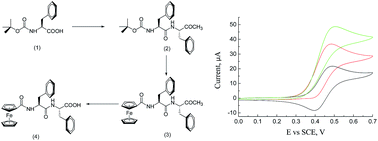A novel ferrocene-tagged peptide nanowire for enhanced electrochemical glucose biosensing
Abstract
Ferrocene (Fc)-tagged peptide nanowires (Fc-PNWs) were synthesized via the self-assembly of Fc-coupled diphenylalanine (Phe-Phe, FF) and then used as supporting matrix for immobilization of glucose oxidase (GOx). Scanning electron microscopy (SEM) characterization indicated that the Fc-PNWs were twisted together with the diameter around 50 nm. The GOx-functionalized Fc-PNWs contained both mediator Fc and GOx for the electrochemical detection of glucose. Thus, by simply dropping the biocomposite onto the electrode surface in a single step, the resulting biosensor displays high sensitivity, wide linear range and good stability towards glucose detection. The good performance of the biosensor originated from the large amount of Fc moieties contained in the nanowire and the facile electron transfer between Fc and GOx. For real sample analysis, the glucose contents in blood samples determined by the biosensor were in good agreement with those obtained using the glucose detection kit. The simplicity of the biosensor preparation process enables mass production of the biosensor with broad potential commercial applications. The synthesized Fc-PNWs can also be used in diverse sensing and biosensing fields.


 Please wait while we load your content...
Please wait while we load your content...